
Very RARE Antique Vintage Magic Fingers Massage Metal Sign, Route 66 Motel
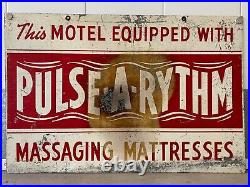
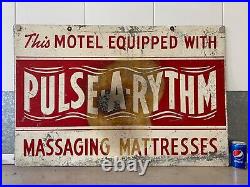
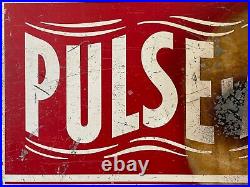

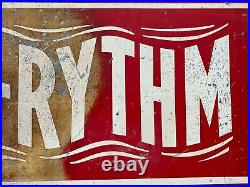
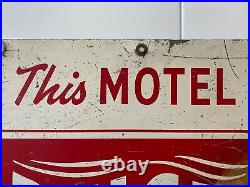
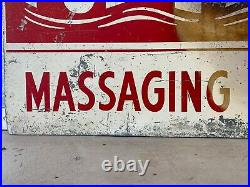
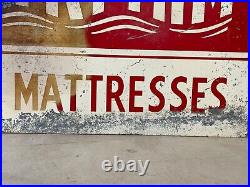
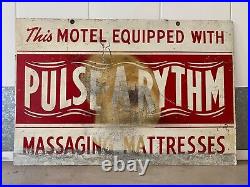
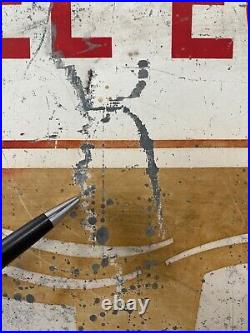
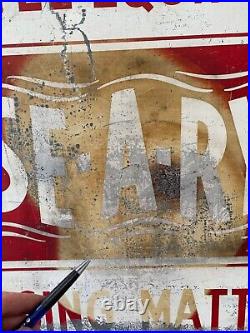
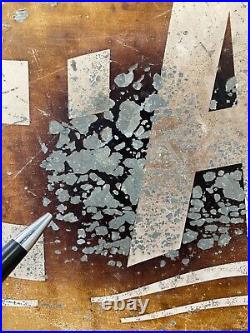

This is a historically significant and Very RARE Antique Vintage Magic Fingers Massage Metal Sign, approximately dating to the 1960’s. Everyone who lived during the 1960’s – 1970’s remembers the massaging beds that were ubiquitous at “seedy” motels, especially places along the historic Route 66. The vibrating motel bed is firmly embedded in the psyche of Mid Century Americana, with only a handful of locations across the country still offering the service. This particular sign was acquired from an old collection in Southern California, and originally was pulled from a small Route 66 motel when it was demolished in the 1980’s. The sign reads: “This Motel Equipped with PULSE-A-RYTHM Massaging Mattresses” on both sides. The graphics on this piece are great, not to mention how Incredibly RARE an original vibrating mattress sign is. Apparently “Pulse-A-Rythm” was a knock off or early competitor of the Magic Fingers vibrating beds and may have been a regional thing that only existed in Southern California. I cannot find any information about this sign, or the company online, and this is likely the only one that still exists. If you do not believe that these signs are extremely rare, I suggest you look online for a comparable one. You will not turn up anything. This sign is approximately 24 x 36 inches, and is in good shape for age and use, with some obvious condition issues such as scuffing, scratches, minor paint loss and oxidation please see photos. This is the only antique original vibrating mattress metal sign you will ever see. A true rarity and artifact of classic Americana. Please check out my other listings for more wonderful and unique items! About “Magic Fingers” Vibrating Beds. A Traveling Standard: The Vibrating Bed. For a quarter, US travelers in the’60s and’70s could find 15 minutes of “tingling relaxation and ease” in hotel beds. An electric device, called Magic Fingers, was mounted to hundreds of thousands of beds, making it a pop culture icon. Magic Fingers inventor, John Joseph Houghtaling (Huff-Tay-Ling), created the machine in his New Jersey basement in 1958. “After ripping away the frills, ” Houghtaling said, I found that it was the vibrator that counted, not the bed. So he tinkered with hundreds of motors in order to find the best one to attach to the box springs of all types of existing beds. The coin operation was modeled after similar units used on televisions and radios. In its prime, about 175 franchise operators installed and maintained Magic Fingers machines across America and it’s reported more than 1 million had been installed in homes and hotels throughout the US and Europe. The decline of the vibration machine wasn’t so much a result of loss of interest as it was thievery. In hopes to keep business moving, Houghtaling worked on a debit card-like system, but the concept was way ahead of its time. But it’s the original device found in motel rooms that gets the most attention. Interesting mentions of the Magic Fingers machine include. In the song “This Hotel Room”, Jimmy Buffet sings. Put in a quarter, turn out the light, Magic Fingers makes you feel all right. Protagonist Billy Pilgrim uses a vibrating bed to fall asleep. A vibrating bed caused a beer explosion in the film. Planes, Trains and Automobiles. Houghtaling was a gunnery instructor during WWII who flew 20 bomber missions. He died on June 17, 2009. They say at the time of his death, some motels in the Western United States still had the Magic Fingers machine installed. Were you a traveler during the’60s and’70s? Did your motel room come equipped with this hit device? Magic Fingers Vibrating Bed. Since it’s that road-trip time of year, my thoughts drift back to the 1970’s when my own family piled into the Skylark and navigated the roads of the American Midwest. Since that would have obviously been pre-internet, the only way to comparison shop the hotels was to read their neon signs as you whizzed by. Signs proclaimed “heated pool”, “color TV” – my favorite sign had some words that ran together to read “air conditioned switchboard”. But what about those signs that also included the mystically named “magic fingers”? In 1958, John Houghtaling invented Magic Fingers, a device mounted onto a hotel bed that would shake the mattress under you for 15 minutes, promising escape from the work-a-day non-vibrating bed world. Let me describe the experience to you. First you drop 25 cents into the coin box at the head of the bed. There is a buzz from deep within the mattress, and very quickly the fine lines printed on the bedspread go into soft focus. Panicked, you wonder whether it’s scientifically possible to rattle the eyes out of your head. Eventually you are able to let go and enjoy the body massage by imagining that you are sleeping on a giant purring cat. You’re able to forget for a while that you’re in a cheap motel, that the vibrating bed has probably been used less for its therapeutic advantages, and more as a giant kinky toy. That’s right, forget it all, let go… And right when you’ve drifted off into a quarter-fueled zen state, your time is up and the bed grinds to a halt. You rack your brain trying to remember where you may have stashed some more change, and the cycle begins again. Magic Fingers still alive, but nearing its finale. The Flamingo Motel in Coeur d’Alene still features the Magic Fingers bed massager. Russ and Rusty Gill were once the region’s Magic Fingers kingpins. In the late 1980s the father-son team from Spokane ran an 80-motel network with 2,000 of the machines, which vibrated a mattress for 15 minutes when a motel guest stuck a quarter into a coin box. By many accounts, the Gills were the last active Magic Fingers operators in the country. In 2002 the Wall Street Journal wrote about the business and said the Gills were probably the last of the Magic Fingers men. At this point, the Gills are writing the final chapter of the Magic Fingers saga. They have just one motel – the Flamingo, in Coeur d’Alene – that’s still using and promoting the mattress-vibrating gadgets. Mead resident Russ Gill, 68, is keeping a stockpile of their last 100 working units. The two men have seen the rise and fall of Magic Fingers, a piece of Americana that makes people think of crewcuts and good vibrations. The strange and unlikely success of Magic Fingers owes a lot to the creative flair of its inventor, a New Jersey entrepreneur named John Houghtaling, who created the device in 1958. Houghtaling convinced motel operators that Magic Fingers was a health aid and comforter, and by the 1970s it was estimated more than 250,000 units had been installed in motels from coast to coast. Russ Gill got into the business in 1983. He always used the same formula with motel operators: He’d take 80 percent, they got the remainder. But by the 1990s, the smaller motels that had Magic Fingers units were being replaced by corporate-owned operations. Many of the national chains, like Motel 6, discarded the units because they saw them as carrying a seedy truck stop taint. Plus thieves began stealing the coin boxes, leading motel owners to consider them more a nuisance than an amenity. As recently as five years ago, Russ Gill still hit the road, maintaining his route. He visited each motel, collected the quarters and serviced the machines, mounted below the bedsprings, that weren’t operating correctly. About five years ago, it just wasn’t worth the time anymore. It wasn’t worth the time driving and the cost of the gas you burned, Gill said. He removed the last couple hundred of his Magic Fingers boxes and put them in storage. His only ongoing motel customer is the Flamingo, which has a unit in all 13 rooms. Gill said he’d have pulled the units out there, too, But Al Williams, the owner, told me to leave them there. He said they’ll stay there as long as he’s around. Williams and his wife, Shelley, see the Magic Fingers units as part of the motel’s retro appeal. “It’s a big point of interest for us, ” Al Williams said. It’s something our guests come in and ask for. If any units break, Williams calls Russ Gill, who’s retired but doesn’t mind driving to Coeur d’Alene with his tool kit. Rusty Gill works as a water systems operator for Pend Oreille Public Utility District in Newport. Those are authentic Magic Fingers units, Russ Gill said, identical to the one invented by Houghtaling, not a knockoff like those found online in the last decade. Each sale sets off a little more relief and regret. For Russ Gill, operating the Magic Fingers route is part of his family’s heritage. His wife’s father, the late Wade Brown, was the pre-eminent Magic Fingers operator in the region. Brown, a car salesman in Sandpoint in the 1960s, decided to go all-in and build a Magic Fingers franchise in the Inland Northwest. His timing was right, because gas was still cheap and long-distance leisure and business travel created a sprawling motel industry. The Magic Fingers device was “probably the first guest-room amenity after the TV, ” wrote Ed Watkins, editor of Lodging Hospitality magazine, in an article on the occasion of Houghtaling’s death in 2009. Over the next 15 years Russ bought the remainder of Brown’s route. But it was his own business and he was in charge, Russ Gill said. For Rusty Gill, the Magic Fingers story is about being with his dad as a teenager and young man, learning how to be a good listener. “It gave me a lot of good memories, ” Rusty Gill said about the years he spent helping his dad make his rounds. From Ritzville to Ellensburg, and from Wenatchee to Walla Walla, they covered a lot of ground and saw a lot of people. Mostly, the son saw his dad treat people right and be successful at the same time. He was born to do this kind of thing. He’s real sharp with business. But he’s also someone that people like to be around. He just has the ability to be easygoing, and people end up liking him. John Houghtaling, Inventor of Magic Fingers Vibrating Bed, Dies at 92. John Houghtaling, an inventor whose best-known product shook postwar America, or at least those Americans who stayed overnight in midprice motels, died on Wednesday at his home in Fort Pierce, Fla. Houghtaling, the inventor of the Magic Fingers Vibrating Bed, was 92. The cause was complications of a recent fall, his son Paul said. Developed in 1958 in Mr. Houghtaling’s basement, Magic Fingers was a ubiquitous presence in the roadside America of the 1960s and’70s. Installed on millions of beds in hotels and motels across the country, it featured a mechanical vibrator attached to the box spring, and a coin meter attached to the vibrator. Activated, “Magic Fingers quickly carries you into the land of tingling relaxation and ease, ” as a label on the device proclaimed. The weary traveler dropped a quarter into the meter, and the mattress surged to life. Fifteen minutes later, when the shaking stopped, the user could either drop off to sleep or pay for another tremulous round. “While the vibrators offer a pleasing sensation similar to weightlessness, no special medical or therapeutic value is claimed, ” The New York Times reported in 1963. It is said, though, that they are of aid in getting to sleep. Combining the thrill of a carnival ride with the pleasure of what could be accomplished, sleeping or waking, on a motel bed, Magic Fingers has insinuated itself into the consciousness of a great many Americans over 40. It has cropped up in a spate of movies, television shows and popular songs, including “This Hotel Room, ” by Steve Goodman, in which Jimmy Buffett sang: Put in a quarter / Turn out the light / Magic Fingers makes you feel all right. John Joseph Houghtaling was born on Nov. 14, 1916, in Kansas City, Mo. The family name is pronounced HUFF-tay-ling. After high school, he held a series of jobs, among them hotel bellman, cookware salesman and a salesman of a remote-control lawnmower. The earliest vibrating beds predated the Industrial Revolution and were powered by household servants. Then came steam power, and after that, electricity. Houghtaling’s great innovation was to separate the motor from the bed. In the late 1950s, Mr. Houghtaling was working as a salesman for a vibrating-bed company. Its product, which combined motor and mattress in one integrated unit, was expensive and unwieldy. What was more, as he said in interviews afterward, it broke down frequently. Tinkering in the basement of his home in Glen Rock, N. Houghtaling tested 300 motors before hitting on one that was light, unobtrusive and made the bed tingle at just the right frequency. At the company’s height in the mid- to late 1970s, Paul Houghtaling said, more than a million Magic Fingers devices were in use in hotels, motels and private homes in the United States and Europe. Houghtaling’s first marriage, to Ruth Donovan, ended in divorce; his second wife, Rita Breier, died before him. He is survived by four sons, John, Mark, Paul and Chris, and a daughter, Alison Lincoln, all from his first marriage; and four grandchildren. Houghtaling’s children have Magic Fingers in their homes, Paul Houghtaling said in an interview on Friday. By the early 1980s, Magic Fingers had begun to fall out of favor with hotel owners. By the standards of late-20th-century in-room entertainment, the device seemed quaint. There was also the matter of guests breaking into the coin meters and stealing the quarters, something they did often. Today, the device is marketed by its current owners for home use. The Magic Fingers Vibrating Bed can still be found in a handful of steadfast motels, mostly in the American West. There, the faithful check in and take to their beds, rolls of quarters in hand. This item is in the category “Collectibles\Advertising\Merchandise & Memorabilia\Signs\Original\1930-69″. The seller is “willsusa_utzeqm” and is located in this country: US. This item can be shipped to United States, Canada, United Kingdom, Denmark, Romania, Slovakia, Bulgaria, Czech Republic, Finland, Hungary, Latvia, Lithuania, Malta, Estonia, Australia, Greece, Portugal, Cyprus, Slovenia, Japan, China, Sweden, Korea, South, Indonesia, Taiwan, South Africa, Thailand, Belgium, France, Hong Kong, Ireland, Netherlands, Poland, Spain, Italy, Germany, Austria, Bahamas, Israel, Mexico, New Zealand, Singapore, Switzerland, Norway, Saudi Arabia, United Arab Emirates, Qatar, Kuwait, Bahrain, Croatia, Republic of, Malaysia, Brazil, Chile, Colombia, Panama, Jamaica, Barbados, Bangladesh, Bermuda, Brunei Darussalam, Bolivia, Ecuador, Egypt, French Guiana, Guernsey, Gibraltar, Guadeloupe, Iceland, Jersey, Jordan, Cambodia, Cayman Islands, Liechtenstein, Sri Lanka, Luxembourg, Monaco, Macau, Martinique, Maldives, Nicaragua, Oman, Peru, Pakistan, Paraguay, Reunion, Vietnam, Uruguay.
- Type of Advertising: Sign
- Country/Region of Manufacture: United States
- Original/Reproduction: Original
- Subject: Route 66
- Color: Red
- Brand: Pulse-A-Rythm
- Time Period Manufactured: 1930-69
